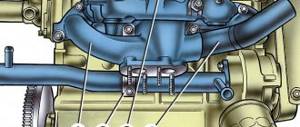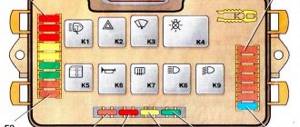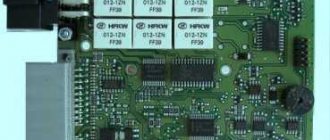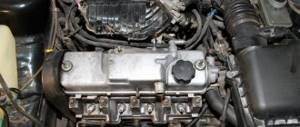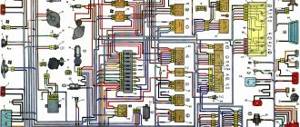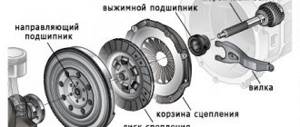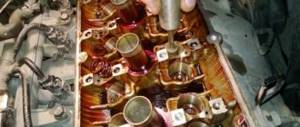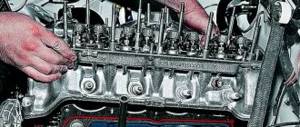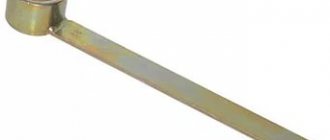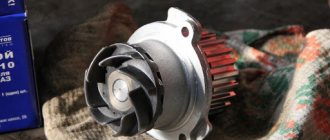The engine consists of two main parts - the cylinder block and the cylinder head, to which all other parts are attached. The joint between them needs high-quality sealing. It is provided by the gasket, which, due to the peculiarities of the engine operating mode, periodically ceases to perform its functions. Replacing the cylinder head gasket is a common repair operation. It may be required both in case of a gasket failure, and as part of a large complex of engine repair work.
Purpose
The function of the cylinder head gasket is to provide a tight seal between the cylinder block and the head. It works in difficult conditions: the engine temperature varies from positive hundreds of degrees in operating mode to negative tens in winter when parked. Aggressive technical fluids: oil and antifreeze attack its surface. It is not surprising that periodically there is a “breakdown” and it has to be changed.
All about the cylinder head gasket and its replacement
Today in the article we will talk about such an important “bolt” in a huge mechanism as the cylinder head gasket (hereinafter referred to as the cylinder head).
First, let's figure out why this gasket is needed?
First of all, the cylinder head gasket acts as a seal between the block and the head. The second equally important task is maintaining the required pressure in the oil system, while simultaneously preventing oil and coolant from leaking from the system.
Keep in mind that this part is consumable and disposable, i.e. If there is any leakage in the system, the gasket must be replaced with a new one.
It is recommended to carry out this work at a technical service center. The cost of the service is quite high, approximately 7000-9000 rubles. The gasket itself is affordable to any wallet; its cost ranges from 200 to 2000 rubles.
If you decide to do the replacement yourself, you will save a lot.
What types of gaskets are there?
Today, 3 main types of cylinder head gaskets have gained special leading positions:
Non-asbestos , advantages:
- remain almost in their original form even after a period of use;
- with minor mechanical damage or slight deformation, they quickly return to their original shape.
Asbestos , advantage:
- elastic;
- plastic;
- heat resistant to high temperatures.
Metal , advantage:
- the most reliable of all listed;
- durable;
- good performance in operation.
Asbestos cylinder head gasket
Non-asbestos cylinder head gasket
Metal cylinder head gasket
If you are wondering “which ones to choose”? The answer will be simple, the choice must be made based on how you personally operate your car, what kind of car (make) you have and how much you are willing to pay for a cylinder head gasket.
How does the car signal that it is time to change the cylinder head gasket?
Since there is no clearly defined replacement period for cylinder head gaskets, you must replace it yourself, at your own discretion, based on several main points.
- car model;
- engine condition;
- driving specifics;
- leakage, etc.
If we talk about any specific signals of cylinder head gasket failure, then these are:
- Oil traces or coolant at the junction of the block and head.
- Detection of light-colored impurities in oil.
- Changed exhaust when the engine warms up indicates fluid in the cylinders.
- Detection of oil stains in the coolant tank.
All of the above points are the most widespread signals of cylinder head gasket wear.
Procedure for replacing the cylinder head gasket.
At the beginning of the article, it was said about the cost of replacing the cylinder head gasket at a car dealership and that replacing it yourself will save a fairly large amount.
When carrying out work yourself, be careful and consistent, adhering to the algorithm of actions.
Algorithm for replacing the cylinder head gasket:
- We turn off and remove all attachments and pipelines.
2. Next, carefully clean the heads of the mounting bolts from adhering oil and dust. 3. We unscrew these bolts. A nuance: we start unscrewing from the middle bolts and without unscrewing them completely (only to unscrew the fastening bolts, and you should start from the middle, turning each bolt no more than one full turn at a time).
4. After completing all the above three steps, we remove the block head and dismantle the worn gasket.
5. Then we carefully clean the “socket” of the block head and gasket, and install a new gasket so that it fits into the grooves.
6. Return the block head to the “socket” and fix it with bolts. Fixation is carried out with a special torque wrench according to a strict scheme developed by the car manufacturer and without exceeding the permitted tightening torque of the engine bolts.
Important: before buying a particular gasket, you need to carefully study whether it suits the required parameters for your car.
After everything is in place, we return all the removed equipment to its place and begin to observe the behavior of the gasket in the first few days.
As you can see, there is nothing complicated in the process, the main thing is to choose the right gasket for your car, and also to do everything competently, carefully and without haste. Good luck!
- It's terribly beautiful. Traveling in a Nissan Qashqai in the North Caucasus
See all photo news >>
Signs of failure
A 100% guarantee of failure of the cylinder head gasket can only be given by its visual inspection after removing the head. Usually the part is hidden from view, and the symptoms of its failure are similar to signs of much more serious problems: warping or destruction of the engine cylinder head. Replacing the cylinder head gasket may be necessary if:
- oil enters the cooling system;
- antifreeze penetrates the oil system;
- it also enters the combustion chambers;
- Exhaust gases leak into the cooling system.
As a result, the following symptoms can be observed:
- liquid leaves the cooling system, but no leaks are observed;
- the engine often overheats;
- the oil level in the engine crankcase rises;
- gas bubbles are noticeable in the expansion tank;
- Thick white smoke pours out of the exhaust pipe;
- there are interruptions in the operation of the engine cylinders;
- antifreeze quickly changes color.
Symptoms may occur together or separately. They do not allow us to unequivocally state that only replacing the cylinder head gasket will be required, but it is a fact that the head itself will have to be removed for final diagnostics.
Symptoms and signs of a blown cylinder head gasket
When the cylinder head gasket is blown, the symptoms of this malfunction manifest themselves in different ways, but the main symptoms are as follows:
- An increase in engine temperature occurs due to a breakdown of the combustion chamber edging. Burning gases enter the cooling system and quickly heat up the antifreeze. When exhaust gases enter the cooling system, violent gas formation is observed in the expansion tank.
- Mixing engine oil with antifreeze and fuel getting into the coolant also result in damage to the cylinder head gasket. The appearance of oily spots in the expansion tank of the cooling system should alert you. In this case, it is no longer possible to do without flushing the cooling system.
- It can be difficult to immediately identify a problem in the engine when interruptions in the operation of the cylinders occur. If the cylinder head gasket between the combustion chambers is burned out, then the fuel mixture in one cylinder is mixed with the exhaust gases of another cylinder. In this case, problems arise when starting the engine, and after warming up the engine begins to operate stably.
- Sometimes the outer shell of the cylinder head gasket ruptures. Then oily streaks can be observed on the surface of the engine at the junction of the cylinder block and the head.
- Often, a cylinder head gasket failure can be determined by the appearance of the exhaust gases. White smoke from the muffler indicates that moisture or antifreeze is entering the combustion chamber. This happens when there is a gap in the gasket between the cooling jacket channel and the combustion chamber.
We remind you that the easiest way to check the cylinder head gasket is demonstrated in the video at the end of the article.
How to buy a cylinder head gasket
In order to purchase the correct spare part, you must have the following information:
- for foreign cars, the VIN of the car is required;
- for domestic cars - the model of the car and the installed engine.
The choice of manufacturers is quite wide; you can purchase an original spare part with the mark of the car manufacturer or a so-called non-original one. In the second case, preference should be given to products from well-known companies specializing in the production of components for engine repair. Their products are cheaper than the original ones, but they are in no way inferior in quality.
It is better to purchase sealing elements from large chains of auto parts stores with an established reputation. Even if the purchased spare part turns out to be substandard, which is extremely rare, large retailers, as a rule, do not have problems with replacement or return.
What, why and why
The cylinder head gasket is designed to accurately seal connections. It immediately and simultaneously contains three most important things in every engine:
- Cooling system channels.
- Engine gas distribution system.
- Oil supply system.
It should be remembered that with almost any intervention in the cylinder head, the replacement of the cylinder head gasket should be done automatically, because this is a common disposable part that is not reused or installed.
If the cylinder head gasket shows signs of sudden death, then you can determine this by the following signs:
- possible leakage of oil and/or cooling system fluid at the joint areas;
- when checking the oil level, a white (translucent) coating may appear on the dipstick, which indicates a leak of coolant through the gasket;
- Light bluish smoke may appear from the exhaust pipe at first after starting the engine, which indicates that the same coolant has entered one or all cylinders;
- A back leak can also occur with oil if, when adding coolant to the reservoir, you see oil stains there.
These are, perhaps, the most typical and main signs of a defect (wear) of the cylinder head gasket, after detection of which it is necessary to change the gasket as quickly as possible.
How to recognize head gasket problems?
Symptoms of gasket failure on one side are quite obvious. For example, the presence of engine oil impurities in the expansion tank or gas bubbles. In addition, coolant may enter the lubrication system. As a result, a deposit forms, which can be found on the oil filler cap. However, mayonnaise-like deposits on the lid also appear as a result of long driving with a cold engine.
Another symptom of a bad head gasket is thick white smoke coming out of the exhaust pipe. At the same time, white smoke also appears during the burning of the particulate filter. In addition, this symptom can be confused with the evaporation of moisture accumulated in the exhaust system.
A good indicator is a tester that detects the content of exhaust gases (CO2) in the cooling system. This set can be purchased on online auction sites. Or you should resort to the services of a car service that has this tester.
Remember that one sign is too few. But, if there is a large loss of coolant along with clear white smoke, then the risk of problems with the gasket or the block head itself is high.
If you have any doubts, contact the service department, since diagnosing faults related to the lubrication and cooling system, as well as the cylinder head gasket, requires some experience.
Why does coolant mix with oil?
This is because the cooling and lubrication channels are usually quite close to each other. When the gasket or the head itself is damaged, the fluids in both circuits begin to mix with each other.
If oil gets into the cooling system, there is a risk of overheating. It's even worse if coolant gets into the oil. Then the risk of engine seizure increases significantly.
A healthy engine does not consume coolant at all. If the antifreeze level drops, there are no visible leaks and all pipes are sealed, then two options are possible. First, the gasket or head of the block is damaged. Second, the exhaust gas recirculation cooler has lost its tightness, which has been happening quite often lately. The symptoms will be the same in both cases.
Gasket and head problems do not always mean that the coolant will mix with the oil. Sometimes coolant does not enter the lubrication system, but into the cylinders. In this case, thick white smoke appears from the exhaust system. You cannot drive for such a long time, since a large amount of antifreeze in the cylinders threatens complete destruction of the engine as a result of water hammer. The fluid cannot be compressed, which places greater stress on the pistons, connecting rods and bearings.
It happens that the cylinder head gasket burns out in such a place that the coolant or oil simply begins to flow out of the engine, but mixing or entering the cylinders does not occur. The situation is not always easy to diagnose, since the coolant, in contact with hot engine parts, quickly evaporates. And a white coating, indicating a malfunction, may be hidden in nooks and crannies that are inaccessible to the eye.
